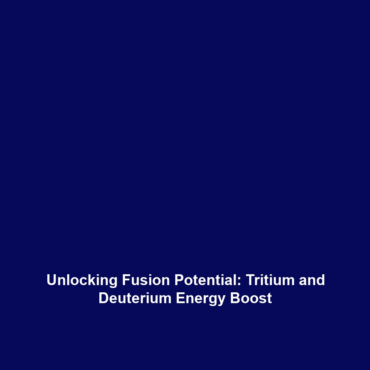Key Breakthroughs in Fusion Energy: Tokamak Design and JET
Introduction
Nuclear fusion, the process that powers the sun, has long been a target for harnessing energy on Earth. The tokamak design developed in the 1950s and the first controlled nuclear fusion reaction achieved by the Joint European Torus (JET) in the 1990s represent significant milestones in this quest for sustainable energy. These breakthroughs paved the way for advancements in Fusion Energy, aiming to provide a cleaner, more efficient alternative to fossil fuels. Understanding the impact of these pivotal designs is crucial as we seek to address global energy demands and climate change challenges.
Key Concepts
Tokamak Design
The tokamak is a device that confines plasma using magnetic fields to sustain nuclear fusion reactions. Developed in the Soviet Union in the 1950s, its design features a toroidal (doughnut-shaped) chamber where deuterium and tritium nuclei can collide at high temperatures, leading to controlled fusion.
Joint European Torus (JET)
Launched in the late 1970s, the Joint European Torus became the first facility to achieve significant controlled nuclear fusion in 1991. JET’s experiments demonstrated the feasibility of producing fusion power and played a critical role in the international Fusion Energy research community.
Applications and Real-World Uses
The breakthroughs associated with the tokamak design and JET have immense applications in the field of Fusion Energy:
- Power Generation: Developing practical nuclear fusion reactors to replace conventional fossil fuel energy sources.
- Research in Plasma Physics: Enhancing our understanding of plasma behavior, which is essential for various applications in engineering and astrophysics.
- Medical Applications: Insights from fusion technology are leveraged in the development of advanced imaging techniques and cancer therapies.
Current Challenges
Despite these advances, several challenges persist in the realm of fusion energy research, specifically regarding the tokamak design and JET:
- Sustaining High Temperatures: Maintaining the extreme conditions required for fusion reactions is technologically demanding.
- Energy Input vs. Output: Achieving a net positive energy output from the fusion process continues to be an issue.
- Material Constraints: Developing materials that can withstand the harsh environment of a fusion reactor remains a key hurdle.
Future Research and Innovations
Looking ahead, research and technological innovations related to the tokamak design and JET focus on:
- Next-Generation Tokamaks: Projects like ITER aim to demonstrate the viability of fusion as a large-scale energy source.
- Advanced Materials: Developing materials with superior resilience against plasma and radiation damage.
- Hybrid Systems: Exploring synergies between fusion and other energy sources to optimize energy generation.
Conclusion
In summary, the tokamak design and the first controlled fusion reaction by JET are pivotal breakthroughs that have significantly shaped the landscape of Fusion Energy. As we continue to face global energy challenges, the implications of these developments offer promising pathways toward sustainable and clean energy solutions. To learn more about advancements in energy technologies, visit our articles on energy innovation and renewable energy sources.









